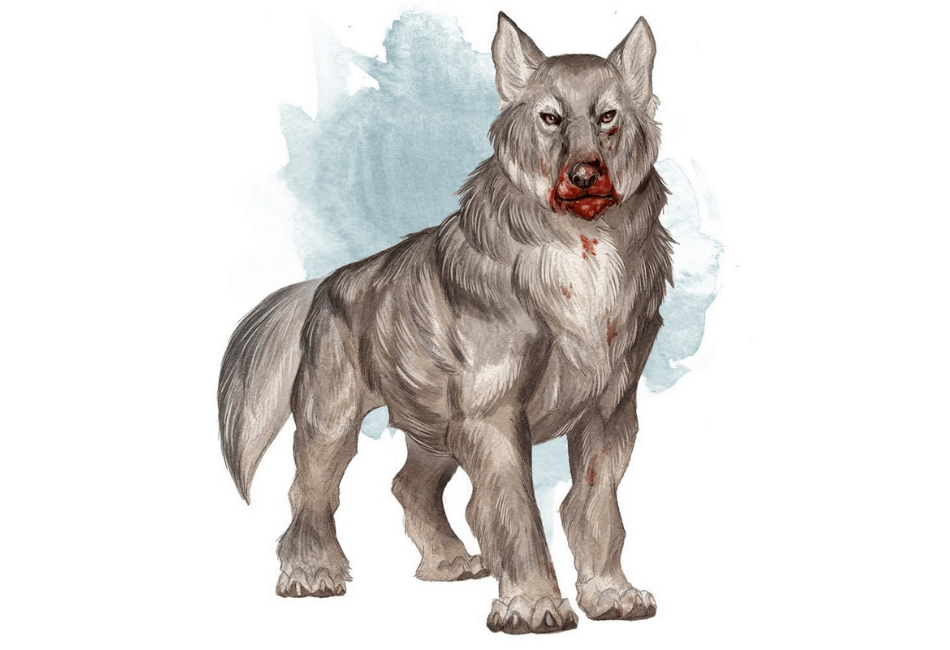The party is moving through the woods, and it is late at night. They’ve just slain a powerful necromancer and are now heading back to the safety of the town.
They are bloodied, bruised, and nearly out of items and spells. But just when they think they’ve gotten to safety, howls fill the air and a very large wolf walks out of the woods, followed by many more. Roll initiative!
Dire wolves are much larger and much more dangerous versions of normal grey wolves, and when it comes time to meet them in battle, you shouldn’t underestimate them because their size and strength are enough to knock most adventurers prone. Plus, they are rarely alone when it comes to fighting.
But what makes this DnD Monster so dangerous? Where would you encounter them? And how do you fight them? Here’s our guide to the dire wolf!
What Is A Dire Wolf?
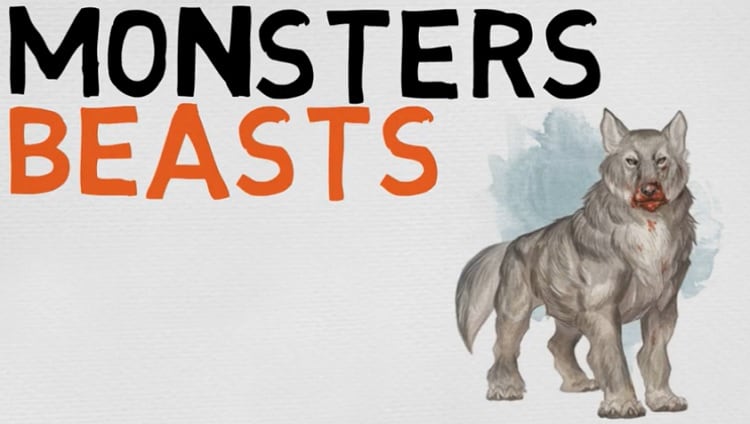
A Dire wolf is an ancient version of a grey wolf, and they are very large and much more feral than the regular wolves of the world. They are about 9 feet long on average and weigh about 800 pounds. They are extremely aggressive and either worked alone or in packs of 3-5 wolves.
The stat block for them gives them an AC of 14, an average of 37 hitpoints, 50 ft of speed, and the following abilities:
Keen Hearing and Smell. The wolf has an advantage on Wisdom (Perception) checks that rely on hearing or smell.
Pack Tactics. The wolf has an advantage on an attack roll against a creature if at least one of the wolf’s allies is within 5 ft. of the creature and the ally isn’t incapacitated.
Bite. Melee Weapon Attack: +5 to hit, reach 5 ft., one target. Hit: (2d6 + 3) piercing damage. If the target is a creature, it must succeed on a DC 13 Strength saving throw or be knocked prone
Breaking those down, we see that if the wolf needs to hear or smell someone coming into their territory, then they have an advantage on that roll. They also work well in packs, so if they are adjacent to an ally and are both attacking the same target, then they will have an advantage on the attack.
They also have a large bite attack which isn’t too dangerous, but if the target is a creature (and that includes humanoids), then they need to roll a 13 or higher on a strength check to stay upright when bitten. If they collapse, then the wolf gains an advantage on their attack rolls as they maul their victim.
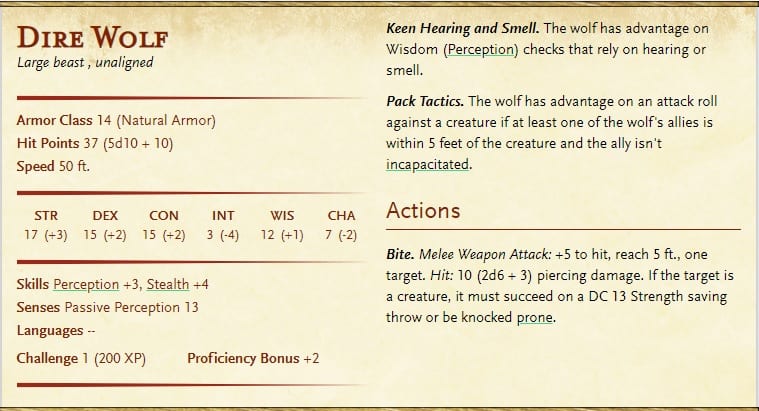
Dire Wolf Tactics
If you have a pack of 3-5 dire wolves, they are going to work together to bring down the weakest prey of the group. They will do this by flanking, getting next to one another, trying to yank the target down with their powerful jaws, and generally trying to get an advantage as much as possible.
They will hit and run as well, using their superior speed to separate the party before coming back around for another attack. They will often smell or hear the party long before they are seen and will use their high stealth skills to creep close enough for an ambush without being detected.
These wolves are very aggressive and are designed to kill, so if you find yourself grappling with them, then they will more than likely fight to the death. This is unlike other wolves who might only fight to hunt or defend their territory and will flee if hurt too badly or their prey flees the area.
Additionally, much like regular wolves, they are very incensed by blood and gore. If your party has been wounded and bloodied from a previous fight, the aggressiveness of dire wolves goes up even more.
All wolves know that blood means that the target is injured and weak, and weakness means that they are food to be eaten and will be much easier to bring down.
Fighting Wolves In A Pack
While most dire wolves prefer to fight alone or in a pack of their kind, there’s nothing that says a Dire couldn’t have alpha wolfed their way to the top of a normal pack of wolves. They can fight alongside a pack of weaker wolves and that causes a different change in the wolves’ tactics.
Wolf packs are always on the move, as they are going to try to separate the party as much as possible so they can go for the kill on the weakest member.
They will run inside, bite their enemy, and then run out of range. If bites succeed, the normal wolves will try to position themselves around the enemy so other wolves can take advantage of the pack tactics. The Dire wolf will behave in the same way.
Wolves in the real world know how to bring down prey and make sure that they don’t get in one another’s way as they do so. Instead, they will run around and feint towards their targets, trying to make the party chase after them.
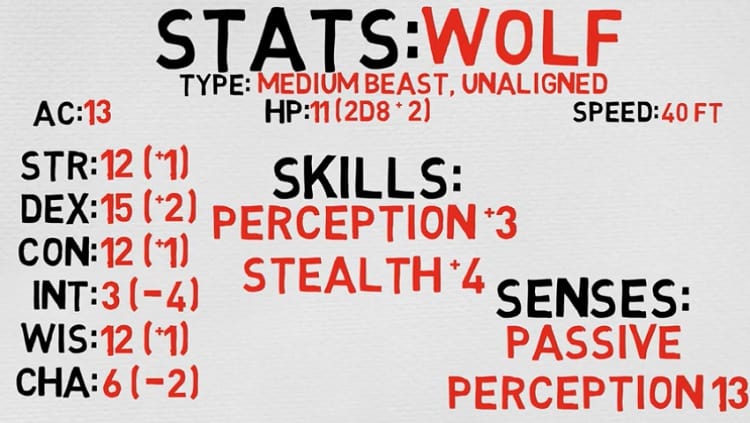
After a few bites, the real attack will begin as the wolves rush in, in greater numbers, some still circling the party while others make rush attacks on the weakest party members.
They will attack in pairs, giving one another advantage and trying to provoke attacks of opportunity so other wolves and enter and leave a player’s space with impunity.
Often this will continue until the party is downed or about a quarter to a half of the pack has been hurt or killed by the party. Hurt generally means that they are down to half hp or less, and they will flee the battle.
How Do You Fight Dire Wolves?
Whether they are with their own kind or leading a pack of regular wolves, your players need to know how to battle dire wolves.
For starters, their tactics of hitting, running, and their high natural speed can be very frustrating for melee players.
The best thing that the heavily armored melee players can do is to back up and form a wall around the weakest party members, making it so the wolves need to go through them before attacking their allies.
Ranged and magic casting characters can easily target the dire wolves because they do not have the highest AC in the world, and some AoE spells can really help damage a lot of the pack when needed. As long as they don’t get swarmed by wolves and brought down by the dire wolf’s powerful bite, this strategy works.
Additionally, the Dire Wolves do not have any resistance to damage types, so you can hit them with everything and they will take the full damage. Some DM’s even play into the animal’s natural fear of fire, and force wolves to take a will save or be panicked when encountering a fire spell.
Variants Of Dire Wolves
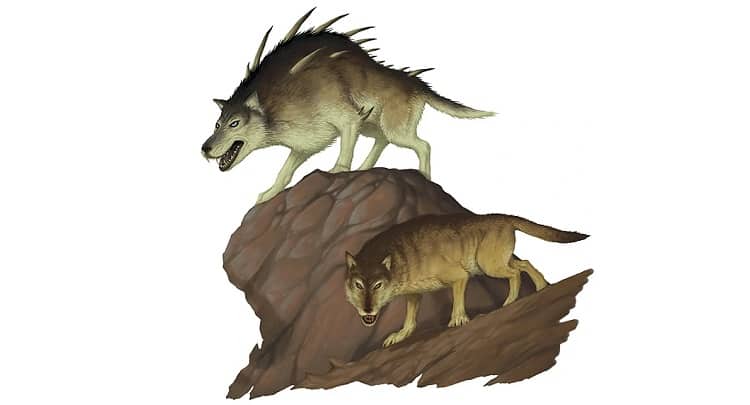
If your party is traveling in the woodlands a lot and will be encountering a lot of wolves, some variants of dire wolves can be really fun to make the combat more interesting.
Perhaps they hear tales of a gargantuan dire wolf that not only has higher stats than the traditional dire wolf but also has a pelt that is resistant to magic as well. Some of the legends even say that they can teleport as well.
Other magical dire wolves, the runebound dire wolves, have runes coating their entire bodies and are able to draw upon those runes to gain abilities. Still, others have made pacts with werewolves and other magical creatures, calling upon their aid and emboldening their brethren with a howl of pure terror and bloodlust.
Fighting a few special wolves can make the endless walking through the woodland much more interesting, and might lead to some epic and memorable battles.
Do Enemies Use Dire Wolves?
While some goblin tribes use regular wolves as mounts and orcs and bandits have been known to use wolves as attack animals and guards, it’s hard to say with dire wolves.
Dire wolves are pretty rare, to begin with when compared to the massive number of grey wolves in the world. Additionally, their inborn aggression will make them very hard to train.
Maybe someone like an enemy druid or sorcerer has one of these rare wolves as a pet, or perhaps a ranger living in the woods has one as a lifelong companion.
Still, these will be the exceptions and not the rules, so for the most part you won’t encounter too many dire wolves running alongside the enemy armies when they march on your towns and villages.
Dire Wolf 5e Guide: FAQs
Question: Can A Dire Wolf Be My Ally?
Answer: If you want to summon a familiar to your side during battles and such, or just to help out, you have a lot of options. Owls, bats, mice, snakes, and more.
But if you want to upgrade to a dire wolf, it depends. The dire wolf is not listed as a familiar in the official rules, but there’s nothing that says a player can’t have a celestial dire wolf if the DM allows it.
Rangers can also have a dire wolf as an animal companion, but the main problem there is that a dire wolf is much more intelligent than a regular wolf. If your ranger decides to use the dire wolf’s intelligence for something, they will have a much greater advantage than if they use a regular wolf.
Again, it might not be a game breaker if both the player and the DM are aware of this and the player doesn’t take too much of an advantage with the intelligence boost. Still, it is not in the official rules.
Finally, druids might wonder if they can shift into a dire wolf through wild shape. The answer is that they can, and they can do so from levels 1-5 thanks to the low CR of the dire wolf. So unless your DM is willing to do a bit of homebrewing, that’s the only way you can have a dire wolf as an ally.
Question: Can Dire Wolves Use Their Claws?
Answer: If you read over the stat block with a keen eye, you might notice that the dire wolf’s main weapon is its powerful biting jaw. However, other four-legged animals have claw attacks as well. If you want to make dire wolves as well as any other wolves more dangerous, you could add a claw attack to them as well.
In order to keep the extra attack balanced, however, you should probably make it weaker than the bite attack and also have it be conditional.
In the real world, wolves will bite and drag their prey down and will typically use their claws for traction and running. They will also use their claws to hold prey in place rather than try to fight with them. So maybe have the wolf try to knock its foe prone with a bite attack, then they can grapple with their claws.
If the prey tries to get up, they need to make a check to escape the grapple and wrestle the wolf’s claws off of them. That would be closer to the real world, but if you want to play less of a real world game and more of a fantasy one, then you can give the wolf very weak claw attacks that it could use.
Question: Do Dire Wolves Fight To The Death?
Answer: If regular wolves flee whenever the pack is too badly hurt or the prey they are hunting is tougher than they thought, what about hyper aggressive dire wolves?
They are tough and focused on both battle and killing, so it is probably a DM decision. Their bloodlust might overwhelm their survival instinct and they could seek to kill as much as possible. Or you could have them flee at a ⅓ of their Hit points to symbolize their toughness.
Either way, they will be a tough foe your party will not forget any time soon!
- DnD Demons Guide: What Are Demons in 5e? - September 18, 2021
- Detect Thoughts 5e Guide: When, Why and How to Use It - September 9, 2021
- The Ultimate DnD Toll the Dead 5e Guide - September 9, 2021

